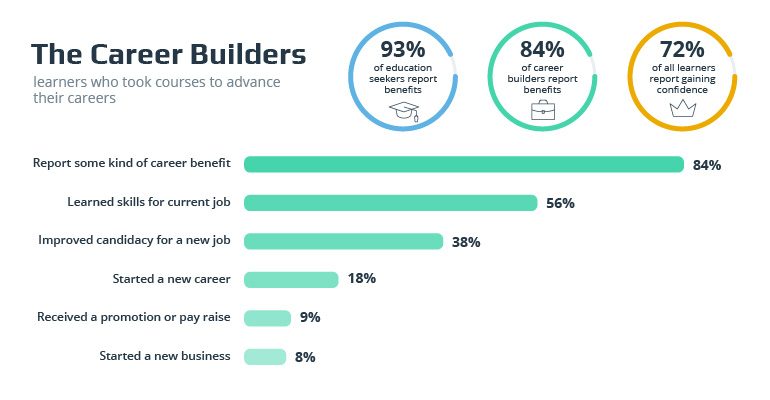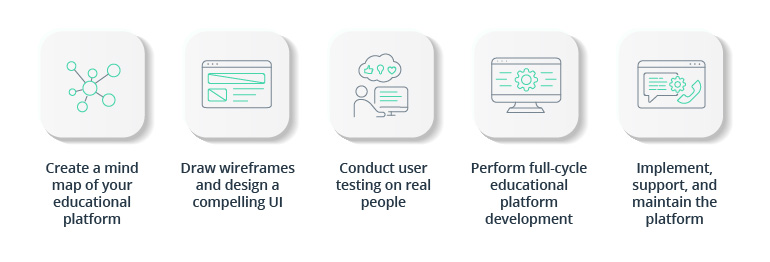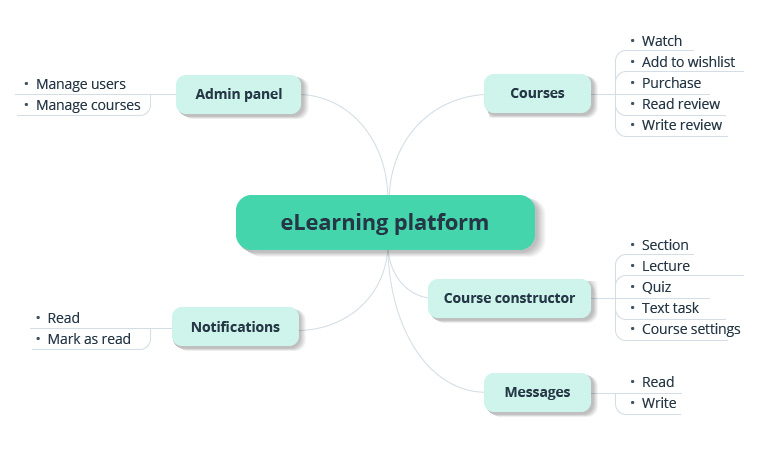Have you heard about real-world superpowers that can change people’s lives? Superpowers are only in Marvel comic books, you might say. But I disagree.
Knowledge is a true superpower that can change your life. You can learn literally anything from how to cook a dish that explodes with taste and flavor in your mouth to how to play rock anthems at your garage concerts. And today, you can acquire knowledge as easily as opening a new tab alongside your favorite Netflix show. This way of learning is possible thanks to online course platforms.

An online educational platform is often the first choice for over busy professionals and knowledge-craving students. The market for educational platforms is growing, and there are plenty of reasons for that. In a Learner Outcomes Survey published by Coursera, 93% of online education seekers and 84% of career improvement seekers reported benefits and tangible results from online platforms for education.
The example of Coursera, which has grown from a hundred to thousands of courses delivered daily, shows that educational platforms are scalable. Revenues gained from online learning platforms justify every penny invested in educational technologies, platform engineering partnerships, and IT maintenance.
How learners benefit from online course platforms

Source: Learner Outcomes Survey by Coursera
Dream of platformication: Why should you develop an online educational platform?

– Attention, class! Name one of the first-born educational unicorns.
– No hands? Okay, one hint. One of them was acquired by LinkedIn in 2015.
– Oh, that’s where we should have started. Lynda.com, that’s right.
A short historical fact: Lynda.com was founded in 1995 by a couple from California – Bruce and Lynda. They started by recording private lessons on VHS tapes and selling them online. That’s how the dream of platformication became a reality.
Ten years later, the popular Lynda.com online course platform with 255,000 videos and 4 million users was acquired by LinkedIn for $1.5 billion. This deal made Lynda.com the first-born unicorn from education.
What’s so special about platforms? Why not develop a simple educational application that provides online courses? Because an online educational platform can unite several distributed applications, offer countless integrations with third-party services, provide tools for creating and administering courses, and do much more.
What is an online educational platform?
An online educational platform is complete software that provides everything you need for a learning experience that feels like what you’d get in a classroom — or even better. An education platform covers IT infrastructure, storage for eLearning courses, data analytics, conferencing, monitoring, and other technologies applicable to education.
Must-have features of an educational platform
- Secure authentication and convenient registration for new users via social media, email, and internal university or corporate systems
- Virtual roles for different types of users within an administrative portal:
- Students can generate their own content, interact with each other, and collaborate in groups
- Teachers can create and upload courses and complement video lessons with additional materials
- Corporate account managers can use the platform to maintain employee training based on an established corporate flow and materials
- Video conferencing tools and virtual classroom simulations to ensure an interactive environment across audiences
- Payment integration for seamless payment processing and the creation of special offers
- Role-based reporting functionality and dashboards accessible for learners and teachers
- Archive of content and integration with video hosting services like YouTube
- DevOps culture to quickly deploy critical updates and regularly ship new features
- Reliable cloud infrastructure built on microservices to run distributed eLearning apps and withstand peak loads
- Authoring tools to create and customize novel learning experiences, quizzes, gamification maps, etc.
- User-friendly interface that prompts actions and explains functionality in a human manner
- Recommendation engine based on machine learning to recommend relevant courses, personalize the learning experience, recognize knowledge gaps, and evaluate students
- Easy enrollment process and a course calendar for individual scheduling
- Notification center to keep users on track with all materials updates and their learning progress
- Evaluation tools and chat bots for customer support
- Valid certifications to comply with education requirements and corporate upskilling programs
Types of eLearning and educational platforms
- Open source learning platforms — Provide an opportunity to customize the learning environment to every customer and organization. Examples: Moodle, Litmos, BrainCert
- Massive open online courses (MOOCs) — Provide the opportunity for instructors, universities, and organizations to upload unique courses and for students to enroll from around the world. Examples: Udacity, Coursera, edX
- Content management systems for eLearning — Provide basic functionality and typically leave customers in charge of generating content, developing learning pathways, and designing user engagement strategies. Examples: Drupal, PHPNuke, CoreMedia
- Video conferencing tools — Provide the ability to communicate via online calls and interactive chats, making them useful for tutoring. Examples: Zoom, Microsoft Teams, Skype
Steps to develop an online course platform into a potential unicorn
To create a successful online learning platform, you need to do some preparatory work in advance. Collecting a pile of courses or collaborating with universities will equip you with content to engage users. Partnering with an eLearning software powerhouse will save you a fortune on building your platform, scaling it, and maintaining all the infrastructure.
When undertaking educational platform development, you should follow a few basic steps to ensure you’re on the right track to becoming nothing less than a unicorn. That’s our target, right?
Steps to confidently build your online course platform

Create a mind map for your educational platform
Everyone needs a plan to start with, and a visualized plan is even better. Present your ideas in a well-structured way by drawing a mind map of what your educational platform should look like. Draw the main features and core parts of the platform around the user. This will be your raw draft. Don’t be shy about including functionality you dream about, as a business analyst will assist you in sorting through your ideas to come up with the core functionality to start development. Everyone is an artist until the specifications and deadlines come along.

Draw wireframes and design a compelling UI
Wireframes of a platform interface will show you weak points where users can drop off. By identifying those weak points right away, you can address them before making mistakes in development. Wireframes help your design and development teams to be on the same page when implementing a product roadmap. User research will lay the foundation for an engaging learning journey. Don’t forget to align all sketches and user flows with your business goals. After all, users should be able to enroll in courses as easily as possible. And paying should be even easier.
Conduct user testing on real people
Testing on real people outside of your organization and development process is like showing your girlfriend or boyfriend to your parents. If you’re afraid of doing it, your fears will chase you everywhere. After all, you’re making a platform for users and expect to have a lot of them. So it’s best to avoid unpleasant reviews. To make the experience as smooth as possible, reach out to various user groups with basic questions:
– What features should we add?
– What makes you stumble in the user journey?
– What elements should be removed?
– Are there any elements you would replace or reposition?
That’s it. And no one will ruin your family dinner.
Full-cycle educational platform development
At this point, you’ve already done a huge part of the work. But you’re facing uncertainty about who will develop this platform. The development process requires you to have a strong engineering backbone in your organization. Maybe you’ll ask your peers to recommend someone to do the engineering work for you, or maybe you’ll find a trusted engineering partner after reading this guide. Why not?
Once you decide who will be responsible for the end to end development of your eLearning platform, it’s time to build estimates and go. Further steps will be defined by the project scope. One quick tip: Consider a microservices architecture from the beginning to increase the flexibility of distributed apps and the scalability of your platform in the future.
Implement, support, and maintain the platform
You’ve already taken so many steps, but our goal is not just to develop and launch an online educational platform. We’re aiming at long-term success by delivering an exceptional learning experience to users. After you hit the market, the next step is to track performance and come up with new features, fixes, and updates. Maintenance and support together with DevOps continuous integration/continuous development (CI/CD) will be your next priority from the technical point of view. All else is the responsibility of your superhero sales team to make the platform profitable.
Role models for educational platforms
Didn’t find your name here? No worries. It’s all in your future with this guide. Just take things step by step

Let’s start developing an educational platform
Educational platform development often begins from a smaller project. For example, you might start with a desktop-based language learning app that you want to scale into a complete platform. That’s what we did for Phase6, a vocabulary trainer for schools, universities, and the enterprise sector. Phase6 had a desktop solution and we delivered mobile versions of their vocabulary acquisition app for iOS and Android. Later, we built a complete educational platform that runs several apps. Phase6 offers this platform to end customers to create their own custom eLearning solutions.
Another scenario is when you already have a running publishing business and want to launch a fully digital service. That was the case with BrainStorm, our Utah-based client who now runs an MS Azure cloud platform for corporate training used by PepsiCo, Visa, and Deloitte. We established an engineering office for BrainStorm to cover all development and DevOps needs.
So what about you? Are you ready to skyrocket your educational platform to reach learners globally and grab the prestigious and profitable status of educational unicorn? Our engineers and eLearning experts will go all in to support you in this endeavor.
Contact Intellias and we’ll create your eLearning product, share our technology culture, and become a partner in the change you make in the EdTech industry.



